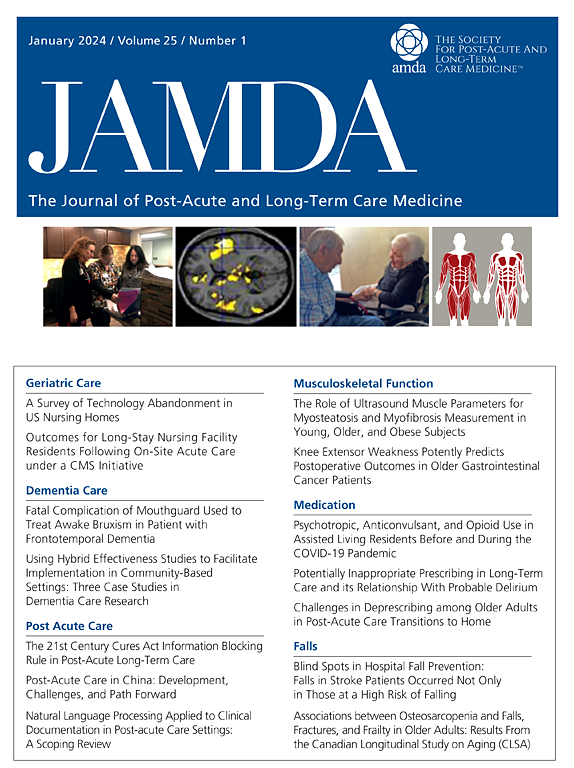向家庭护理过渡中的不平等:加拿大老龄化纵向研究纵向分析》。
IF 4.2
2区 医学
Q2 GERIATRICS & GERONTOLOGY
Journal of the American Medical Directors Association
Pub Date : 2024-10-15
DOI:10.1016/j.jamda.2024.105307
引用次数: 0
摘要
目标:调查加拿大中老年人在向家庭护理过渡过程中,因人口和社会经济因素而产生的不平等:调查加拿大中老年人在向家庭护理过渡过程中因一系列人口和社会经济因素而产生的不平等现象:设计:纵向、回顾性队列研究:利用加拿大老龄化纵向研究(Canadian Longitudinal Study on Aging)提供的全国数据,从 2011 年到 2021 年的 3 个时间点,共收集了 51338 名 45 岁以上居住在社区的成年人:我们使用多态马尔可夫模型分析了家庭护理使用的过渡情况,将家庭护理使用和不使用作为瞬态,将失去随访作为终态。我们计算了各州之间过渡的危险比,并对以下公平阶层中与家庭护理需求相关的因素(即功能限制、慢性病)进行了调整:收入、教育、移民史、性别、性别、乡村、种族背景和有形社会支持:在所有时间点上,5.4% 的非居家护理用户在下一个时间点过渡到居家护理,33.2% 的居家护理用户在下一个时间点继续使用居家护理。在非居家护理使用者中,女性、白人、教育程度较高、收入较高和可获得的支持较少与过渡到使用居家护理的可能性增加有关。在家庭护理使用者中,与收入较低的使用者相比,收入较高的使用者停止使用家庭护理的可能性也更大。收入与使用家庭护理之间的关系在女性中更为密切:我们发现,在家庭护理过渡方面,不同收入阶层之间存在着显著差异。收入越高的人越有能力获得私人护理,这就造成了在获得家庭护理服务方面的不平等。收入和社会支持等性别因素与家庭护理的使用有着重要的关联。家庭护理规划和政策必须解决不同人群面临的独特障碍和不利因素,以确保公平使用家庭护理并促进健康老龄化。本文章由计算机程序翻译,如有差异,请以英文原文为准。
Inequalities in Transitions to Home Care: A Longitudinal Analysis of the Canadian Longitudinal Study on Aging
Objectives
To investigate inequalities in transitions to home care across a broad set of demographic and socioeconomic factors in Canadian middle-aged and older adults.
Design
Longitudinal, retrospective cohort study.
Setting and Participants
A total of 51,338 community-dwelling adults aged 45+ years, using national data from the Canadian Longitudinal Study on Aging across 3 timepoints from 2011 to 2021.
Methods
We analyzed transitions in home care use using multistate Markov models, with home care use and nonuse as transient states, and loss to follow-up as a terminal state. We calculated hazard ratios for transitions between states adjusting for factors related to home care need (ie, functional limitations, chronic conditions) within the following equity strata: income, education, immigration history, sex, gender, rurality, racial background, and tangible social support.
Results
Across all timepoints, 5.4% of non–home care users transitioned to home care by the next timepoint and 33.2% of home care users continued to use home care at the next timepoint. Among non–home care users, identifying as a woman, female, white, completing higher levels of education, having higher income, and having less support available was associated with an increased likelihood of transitioning to home care use. Among home care users, higher income was also associated with a greater likelihood to discontinue using home care compared with lower income users. The association between income and home care use was stronger among female individuals.
Conclusions and Implications
We found meaningful differences in home care transitions across several equity strata. Individuals with higher income have greater ability to access to private care, creating inequity in access to home care services. Gendered factors such as income and social support have important associations with home care use. Home care planning and policy must address the unique barriers and disadvantages diverse populations face to ensure equitable use of home care and promote healthy aging.
求助全文
通过发布文献求助,成功后即可免费获取论文全文。
去求助
来源期刊
CiteScore
11.10
自引率
6.60%
发文量
472
审稿时长
44 days
期刊介绍:
JAMDA, the official journal of AMDA - The Society for Post-Acute and Long-Term Care Medicine, is a leading peer-reviewed publication that offers practical information and research geared towards healthcare professionals in the post-acute and long-term care fields. It is also a valuable resource for policy-makers, organizational leaders, educators, and advocates.
The journal provides essential information for various healthcare professionals such as medical directors, attending physicians, nurses, consultant pharmacists, geriatric psychiatrists, nurse practitioners, physician assistants, physical and occupational therapists, social workers, and others involved in providing, overseeing, and promoting quality

 求助内容:
求助内容: 应助结果提醒方式:
应助结果提醒方式:


